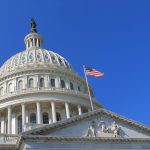Published October 16, 2014
The Treasury Department announced yesterday that the federal budget deficit was $483 billion in fiscal year 2014 — down from $680 billion in fiscal year 2013.
The Obama administration is touting this news (foreshadowed by a Congressional Budget Office release last week) as evidence that the president’s policies are working, and to claim that worries about massive future deficit spending are overblown. John Podesta, counselor to the president, took to the op-ed pages of the Washington Post last week to lay out the administration’s case on these matters.
It is an exceedingly weak argument.
It begins with a sugar-coated version of the Obama fiscal record. Yes, the federal budget deficit fell to 2.8 percent of GDP in 2014 — but that’s after a five-year run-up in federal debt unseen in American history. From 2009 to 2013, the federal government borrowed $5.8 trillion, essentially doubling U.S. debt. Put another way, during the Obama presidency, the federal government borrowed as much over five years as had been borrowed cumulatively by the federal government from 1789 to 2008.
Moreover, the budget outlook, even over the medium term, is very bleak. The most recent forecast from the Congressional Budget Office (CBO) indicates that the federal government will run a cumulative deficit of $7.2 trillion from 2015 to 2024. By 2024, federal debt held by the public will reach 77 percent of GDP. Federal debt has not been that high as a percentage of the U.S. economy since 1950.
And even these projections are unrealistic. They assume that defense spending will fall to just 2.7 percent of GDP in 2024 — a level not seen since before World War II. Policymakers from both parties are now making it clear that the Obama administration’s plans for national-security spending are completely unrealistic. It is far more likely that the country will be required by global realities to spend closer to the post-war average on defense — around 4 to 5 percent of GDP — over the coming decade. That shift alone would add trillions to cumulative federal debt by 2024.
Beyond the next ten years, the outlook is even worse. CBO’s most recent long-term forecast shows federal debt rising to 100 percent of GDP by 2036. This assumes that spending outside of the large entitlement programs will fall by one-quarter as a percentage of the U.S. economy — a completely unrealistic assumption. A slightly more realistic set of assumptions shows federal debt exceeding 100 percent of GDP by 2029.
Podesta attempts to brush all of this aside by claiming that the Affordable Care Act (ACA) — i.e., Obamacare — has ushered in a new era of more-moderate health-spending escalation, and that this change alone will ease fiscal pressures in future years.
This is nonsense.
Health-spending escalation was slower in recent years than it was in previous decades, but it wasn’t because of Obamacare. That’s the conclusion of the top experts in the executive branch — who work for the Obama administration. The actuaries who make Medicare-spending forecasts and track national health expenditures attribute most of the slowdown in spending to the sluggish recovery from the deep recession of 2007–09. Their analysis indicates that these years have not been anomalous but in fact fall within what would have been predicted based on prior experience during recessions and their aftermaths.
Recent international trends back up this conclusion. A study by the Organization for Economic Cooperation and Development (OECD) found that the slowdown in health spending experienced in the U.S. since the financial crash has also been observed throughout the developed world. Even Obamacare’s most ardent defenders would be hard pressed to come up with a theory for how Obamacare is responsible for health-spending deceleration in Japan or Switzerland.
Attributing the health-spending slowdown to the ACA also defies common sense. The much-touted “delivery-system reforms” included in the law are trivial items in budgetary terms. CBO assigned a grand total of $13 billion in federal savings over ten years to Accountable Care Organizations and the provision penalizing hospitals for excessive readmissions. Over that same period, the Medicare program alone will spend $6.9 trillion.
Much more consequential is the ACA’s massive infusion of new subsidies for third-party insurance. CBO now projects that the Medicaid expansion and the premium credits for insurance offered through the law’s exchanges will cost $1.8 trillion over the next ten years. It is basic economics that the injection of this much federal money into the insurance system will increase demand for medical services and drive up prices and costs. It is just a matter of time before these predictable consequences of the law become visible in the nation’s health-spending accounts.
Ironically, the most consequential health-spending cut in the ACA is the one the Obama administration never wants to discuss. The “productivity adjustment factor” imposes an indiscriminate, across-the-board cut every year to the inflation update that otherwise would apply to Medicare’s reimbursement rates for hospitals and other providers of services. The cumulative effect of this cut would be massive — so massive, in fact, that the Medicare actuaries don’t believe it will be implemented over the long run, because it would reduce access to services for the program’s enrollees. The actuaries are so skeptical that this cut can be sustained that they have issued an alternative projection to the official trustees’-report forecast of Medicare finances every year since 2010. These alternative projections assume that the “productivity adjustment factor,” like the similar cut that is scheduled to apply every year to doctors’ fees, will eventually get repealed. And when it goes, so too do the supposed long-term savings from Obamacare.
Podesta scolds those concerned about projected deficits by arguing that what’s needed most now is a pro-growth strategy to promote job creation for the middle class. He is certainly right about that. But it seems not to have occurred to him that pursuing the same policies that produced the anemic growth rates of recent years is unlikely to bring a better result now.
The most pressing fiscal challenge facing the country is the explosion of entitlement spending that is already underway with the aging of the baby-boom generation. Instead of addressing this problem, the president compounded it. He pushed for enactment of two new entitlements even as he resisted any serious attempts at reforming the existing programs. The result is a massively overextended federal government.
At some point, the music will stop, and a crisis will ensue. And when it does, President Obama will richly deserve the portion of the blame that will surely come his way.
James C. Capretta is a senior fellow at the Ethics and Public Policy Center and a visiting fellow at the American Enterprise Institute.








